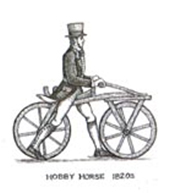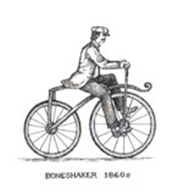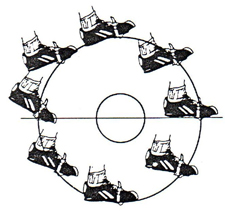Talking of Bicycle Evolution
 Thu, March 4, 2010
Thu, March 4, 2010  My recent talk here in Charleston (Part of a bicycle lecture series.) was well received, with about 80 people present.
My recent talk here in Charleston (Part of a bicycle lecture series.) was well received, with about 80 people present.
The subject of my Power Point presentation was The Evolution of the Bicycle over the years.
In preparing for my talk it occurred to me that it was 1950 when I got my first lightweight bike, in other words, 60 years ago; I started racing two years later.
The first chain driven “Safety” bicycle, the Rover was built in 1886; this was 124 years ago. I realized my involvement with bicycles was for almost half the time the bicycle as we know it has existed.
Furthermore, people who influenced me early on were around at the beginning of the bicycle’s history.
A.J. “Pop” Hodge, (Picture above from 1952.) the man who was my mentor was born in 1877 and at the time he first showed me how to build frames was older than I am now. He began building frames in 1905; Pop died in 1966 at age 89.
The bicycle has no clear single inventor; no Thomas Edison or Alexander Graham Bell. Rather a number of people simply improved on an idea that had been around probably for centuries in the form of a child’s toy; a pretend horse on wheels that the child sat on and pushed themselves along with their feet.
 It wasn’t until this child’s toy became an adult toy around 1820 that people no doubt discovered when coasting downhill, one could lift their feet from the ground, and actually balance and stay upright on two wheels.
It wasn’t until this child’s toy became an adult toy around 1820 that people no doubt discovered when coasting downhill, one could lift their feet from the ground, and actually balance and stay upright on two wheels.
What does surprise me is that it took another 30 or 40 years before someone added a simple crank to the front wheel, thus turning a toy into a viable form of transport.
 One has to realize the only other practical form of personal transport up until that time was the horse.
One has to realize the only other practical form of personal transport up until that time was the horse.
The bicycle was a machine that would take you where you needed to go, and you didn’t need to feed it, or even saddle it up or hitch it to a cart.
From that point on the evolution speeded up over the next ten years as the front drive wheel became ever increasing in size.
 People realized the larger the wheel, the more distance traveled per wheel revolution, resulting in more speed. The only limitation was the length of the rider’s legs.
People realized the larger the wheel, the more distance traveled per wheel revolution, resulting in more speed. The only limitation was the length of the rider’s legs.
The high wheeler was the first enthusiast’s bike; cycling became an athletic sport. In fact a person had to be an athlete, and have a certain amount of bravado to even mount and ride one of these somewhat dangerous machines.
Some of these high wheelers weighed as little as 19 lb. Comparable to a lightweight bike today. Bicycle racing became a sport, and speeds well in excess of 20 mph were achieved. The one hour record was over 20 miles.
 When the Rover “Safety” bicycle came along (Right.) it opened up cycling to those less brave, or athletic; including older people and women.
When the Rover “Safety” bicycle came along (Right.) it opened up cycling to those less brave, or athletic; including older people and women.
However, it was heavier and no faster than the Ordinary, and was not immediately accepted by the real enthusiasts.
It wasn’t until the pneumatic tire was invented that the Safety bicycle became faster, and the high wheeler gradually died out.
Its influence on bicycle design however, would remain for the next 60 years or more.
Because the steering was near vertical on the Ordinary the only place a rider could sit was some distance back behind the pedals. About 70 or 71 degrees to be exact, and seat angles on racing bikes would remain there up until the 1950s when I started racing.
There was no rhyme or reason for a person to sit that far back behind the pedals, other than enthusiasts who really thought they knew what they were talking about, said it was so.
 Saddles were set low by today’s standard and “Ankling” was preached.
Saddles were set low by today’s standard and “Ankling” was preached.
Old style Ankling which is what I speak of here, is a style of pedaling where the heel goes down at the start of the downward pedal stroke, and up on the up stroke. (Picture left.)
This is a direct throw-back to the High-wheeler. Cranks then were relatively short in order to make the wheel diameter as large as possible; the pedaling motion was mostly an ankle movement. Riders of the old Ordinary did develop huge calf muscles.
By the 1950s cranks had become longer and although Ankling was still taught and practiced, when pedaling at high revs, it became impossible to maintain. Not only that, at maximum effort the rider found himself slipping forward on the saddle because the seat angle was so shallow.
I remember phrases like “You have to sit back to pedal,” and “Good climbers ride sitting down.” These were almost religious mantras, which at the time should not be questioned.
In my next article I’ll explore this theme of evolution into more recent years


















Reader Comments (10)
This is a fantastic introduction to bicycle (and technological) evolution. I'm really struck by this:
That gets to the radical democratizing potential of the bicycle. It really does give "power to the people." In on a few decades distances of 50-100mi/day were accessible via personal transport to (almost) everyone, not just those who could afford horses (or, later, cars). Bikes are also much cheaper/simpler to build than carts or wagons and require very little in way of roads & infrastructure. It is on this obvious but little-recognized fact that I feel confident in imagining that bikes will henceforth be a permanent fixture of civilization.
Do you have a PowerPoint or video you can share?
Great post Dave, looking forward to part 2.
More, more! I've always been a history buff, but bicycle history - as short as it is - is one of my favorite topics.
I'm on the edge of my seat for part 2!!
Thank you Dave, for the continued insider view of the passion you provide a regular rider like me.
I would have enjoyed seeing your presentation in person. Too bad I live no where near Charleston. The weather was likely better also.
Wonderful -- looking forward to Part 2. You have a valuable perspective and a disarming way of conveying your insights. This blog is one of my regular places to visit. Ride on.
Dave Re the ankling bit, I have a book 'Lets go cycling' by Reg Shaw pub May 1950. Section Easy Riding. He states,The more skilful the cyclist becomes the more he uses his feet as though they were hands.Example, is the way in which a girl or woman turns the handle of a sewing machine, she does not turn it around by bending and straightening her arm at the elbow joint,She does make use of her elbow but she also brings her wrist into use. OF COURSE now its all electric. Like you in the 50s I was told to sit back and climb in the saddle, still works for me after 60+years, My 40 yrs old son is the oposite he sits forward and honks up the hills. TRYING to keep up with me! Part 2 should be VERY INTERESTING!
I'm certain this is the first time I've seen a picture of my great grandfather "Pops" Hodge on the web, wonder what he would have thought? Despite growing up in Luton I never knew him, but I had a Hodge bicycle as a teenager, passed on to Hodge cousins when I got too big for it.
Thanks for the mention and the history.
Bob Palin
Torrey, Utah
Wow.its amazing how the little things we do can affect lives. Keep this program up.
In a bikeforums thread on frame alignment, I relayed your description of how Pop Hodge laid out a frame for brazing. A reply correctly admonished me for referring to the wrong process (establishing frame dimensions vs frame alignment). How did Pop Hodge check the alignment of frames after brazing?